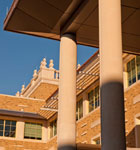Since opening in November 2011, the Rawls College of Business Administration (RCoBA) building has symbolized the drive for institutional sustainability at the Texas Tech University System. “The building represents Texas Tech University System’s $1 billion campaign to create cutting-edge, sustainable facilities,” explains Michael Molina, vice chancellor for facilities planning and construction.
The building, constructed to qualify for LEED Silver certification, is a three-story structure with a lower-level basement. Its 149,000 square feet of space houses the Rawls College of Business Administration’s five academic departments—accounting, marketing, management, finance, and energy commerce—and is the first of several environmentally focused construction projects planned for the University System which, along with Texas Tech, includes Angelo State University and the Texas Tech University Health Sciences Center.

The elegant building that houses Texas Tech’s Rawls College of Business Administration was built on a foundation made from the debris of Thompson-Gaston Hall.
Energy efficiency is a prominent feature of the facility. Expansive window space utilizes daylight to reduce dependence on electrical lighting, while automated systems switch off lighting when not needed. The use of fluorescent lighting with electronic ballasts has meant significant cost savings. Meanwhile, specially designed glass windows help retain heat in the winter and reflect it during the summer. “These measures have led to a 15-percent reduction in energy consumption,” says Hugh Cronin, the university’s senior director of project administration.
A 45-percent reduction in potable water is evident through waterless urinals, low-flow fixtures, and sensors. Storm-water runoff has been minimized through retention ponds that promote the natural filtration of rainwater into surrounding soil.
True to the project’s aim of limiting waste, even the concrete and brick from Thompson-Gaston Hall—the former student residence demolished to make way for the Rawls building—has been utilized. “The debris was crushed and employed as fill for the new building,” Cronin says.
Hopes are high that the RCoBA building’s high green quotient will measure up for the sought-after LEED Silver certification, which will be submitted later this year. “Thirty-three points are needed for a Silver rating,” Cronin says, “but we could score as high as 36 to 39 points.” Molina and the Texas Tech leadership are optimistic that the RCoBA building may set a precedent for sustainable construction beyond their campus. “Many architectural firms, including those who have worked well with us, such as SLS Partnership, have responded favorably to this effort,” Molina says. “Hopefully, we will inspire other regional developers to adopt green construction practices.”

